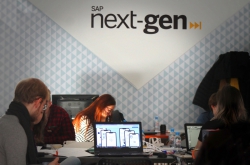We know quite a lot about Microsoft’s partnership with different educational and administrative organizations in regards to providing software and other interactions, which have already become traditional. However, we know significantly less about the partnership between Microsoft and different institutions, including universities, in the line of developing “smart” cities. Tell us about this form of partnership.
I have come here to discuss topics connected to the project ITMO University plays an important role in - “Smart St. Petersburg”. We are discussing those areas that, from Microsoft's point of view, are important in the context of smart cities, and where we could jointly launch pilot projects with ITMO University, trying out new technical solutions, especially in the areas of the Internet of Things, Big data, machine learning, artificial intelligence and cognitive services. All of the above are the innovative technologies that are now placed on the Microsoft Azure cloud platform, and which consider to be the most promising in the context of the development of smart cities and regions.
There is another topic related to "smart" cities - "smart" campuses. By campus we mean a set of buildings - for example, the buildings of a university, multi-profile hospitals, elements of the administrative infrastructure. Here many interesting problems arise in terms of managing the engineering structure, the whole environment – particularly, heating, light and others. Based on advanced technologies, it is possible to develop solutions for health care, for secondary and higher education. For example, now we are doing pilot projects with the Financial University under the Government of the Russian Federation, testing the elements of a smart campus, where, with the help of technology, we can control the air quality and light levels in the building.
There are even more exotic applications of technology. For example, we can use the cameras located in the building to analyze the flow of students, as well as employ face recognition technology to keep track of the flows of students, and on the basis of face recognition technologies, one can understand students’ real attendance rates. Using emotion analysis, one can track whether students are immersed in the learning process, how much they like or do not like the teaching process of this or that subject. All of this is possible by virtue of cognitive technologies: computers are able to recognize emotions, natural human speech, and all of this can be applied in an interesting form in the field of "smart" cities. Machine learning technologies allow one to predict the possibility of learning problems for a particular student and even warn about possible risks. All of these ideas are currently being discussed.

Several parties are involved in the implementation of the concept of "smart" cities: these are the institutes of urban studies, as well as private companies and the state. What is the contribution of different institutions in the implementation of projects of "smart" cities and regions?
Everyone has an assigned role. Ultimately, the city and region administrations provide the initiative and manage the process. It is the administration's responsibility to ensure that these processes are launched. This is not easy, because the topic of smart cities is a very extensive one. It includes a “smart” digital administration, security, transport, management of urban utility systems, buildings, water supply, energy engineering, health-care management at the level of the local territorial bodies (we are not talking about automation of hospitals here, but rather about health control on a certain territory in general), as well as "smart" tourism and culture, education, etc. Further on, the "think tanks" get involved in this process: universities are important here, as they represent the scientific expert community, and so are the companies that offer solutions, particularly the local ones that are well aware of how a city's activities are organized. International companies, such as Microsoft, play a certain role, too, as they represent a wide range of platform technologies that can be used to create solutions. Nobody is a monopolist here, but there is a large number of parties involved.
Microsoft offers the CityNext initiative to various cities. What does it entail?
This is an umbrella initiative that aims to create "smart" digital cities and regions. Within this framework, companies have their vision of what kind of solutions are required for different cities now and in the future to ensure sustainable economic development and create a comfortable environment for city dwellers to live in. The initiative includes a long list of areas ranging from security to transport infrastructure. We have a vision of what technologies are needed to create a wide range of solutions. Microsoft rarely practices creation of real industrial solutions, we are presenting a platform on the basis of which our partners are creating solutions for their specific needs. However, we have a clear vision of the technologies that will be in demand in most solutions for "smart" cities and regions.
Creating "smart" cities and regions involves, for the most part, collecting and processing large amounts of information, including the information collected from what is called the "Internet of Things". These are the sensors and video cameras that control traffic, living conditions in the city and more. Mobile phones are also, in a way, sensors, which, with the consent of users, can provide a lot of information about the human flow. Big Data is processed in real time , letting us predict in which direction the situation evolves and anticipate and prevent problems. For example, one can predict the traffic situation in the next 30 to 60 minutes, and, having realized that it is developing in a negative way, offer solutions that will mitigate the negative consequences. Data processing requires the use of intelligent algorithms with elements of machine learning and the use of technologies allow infrastructure to be managed effectively. Microsoft has included a wide range of these technologies in its cloud platform; companies can take these technologies and make ready-made final solutions for the city's territory without spending vast resources on creating basic elements of solutions. The CityNext initiative allows the creation of a wide range of urban solutions, first of all, to our partners both foreign and local. We are looking for those who are ready to employ innovative solutions for smart cities.

To what extent is St. Petersburg open for the CityNext initiative?
Our collaboration with St. Petersburg is currently within the limits of a regular partnership. At the same time, we are now heading towards the launch of innovative technology applications in St. Petersburg. In the course of the dialogue with the implementers of the "Smart St. Petersburg" project, we hope to find areas in which it will be possible to launch pilot projects.
In the summer of 2015, at one of the conferences, you pointed out that there are five key "smart" city technologies which, at the time, had just become available, but they were very promising. Among them there was the technology of cloud computing, Big Data analysis, the technology of mobile computing, social communications and Internet of Things. How do these technologies change the lives of urban residents today, two and a half years later?
I'm 100% sure that, at this stage, these technologies are only starting to become popular The interest in technologies has increased in our country, especially in connection with the digital economy initiative and the corresponding program, which are being discussed at the highest level. They started to create working groups on different assignments within the digital economy, so all these megatrends have become an integral part of the digital economy initiative. The rate at which these technologies are developed and adopted will increase. I believe that we will see them used on a larger scale in the next few years.

There are initiatives that could facilitate the life of the city and its residents, but which often cannot be put into practice because it would radically change the entire business structure. Earlier on, you told us about the technology of saving on housing services and utilities payments... To what extent can these projects be implemented?
There are two main aspects here. The first aspect is technical: is it possible to solve this particular problem technically? The second aspect is statutory and regulatory. In this case, we understand that the technical part of the problem is solvable, and we realize that we can solve it not even tomorrow, but right now. The next question is whether those resource-supplying organizations that are engaged in maintenance of housing and communal services are interested in the implementation of this project. In other words, will the resource-supplying organization be interested in saving its resources, or, on the contrary, will it want its resources to be used more extensively? Here, the state takes up the role of the moderator, since it is important that such a statutory and regulatory system is created in the market. This system is necessary in order to ensure the introduction of new technologies that guarantee efficient operation of the city economy and ensure the saving of resources that are not in any way unlimited.
The question of techno-economic feasibility is asked often, and this is a very wide range of issues, because the effects from the introduction of new technologies are very often seen not only in the field of physical savings of heat, gas, water, electricity and other resources, but are often associated with the total possibility of reorganizing the business-processes, including in the sphere of municipal economy. A good example is when using "smart" technologies, we can manage boiler houses on a certain territory: instead of using local teams, we can remotely monitor the situation and issue the necessary heat supply taking into account external factors that the computer can calculate (equipment condition, weather forecast); we may also provide remote maintenance of boiler houses.
On the basis of predictive and analytical methods, the information systems will comprehend that some equipment begins to degrade in its technical parameters, and, thus, it will become possible to prevent emergency situations. All these possibilities can reduce operating costs of boiler-houses and give us 10-30% savings of such resources as fuel, electricity, water. At the same time, due to the accuracy of the forecast of the resources used, the savings in financial terms will be even greater, because the contracts for the supply of fuel are drafted in the following way: if you go below or above the contracted volume, you will pay with an increased ratio, and, using computer technology, you can more accurately predict the necessary volumes and get into the narrower frame of limits, thus, without overpaying for overspending or not spending the volume. So, this is a story not only about savings, but about the reorganization of business processes.

Urban residents today notice the changes in transportation, medical and administrative infrastructures. Tell us about the non-obvious applications of "smart" technologies within the scope of the concept of "smart" cities and regions?
We now have pilot projects related to improving the quality of services rendered in the Multipurpose centers - the physical infrastructure for rendering of public services, which works quite effectively and which many our citizens have already used. When you come to a Multipurpose center, after you have received the service, you can click on a button and choose whether you enjoyed or did not enjoy the service. Now there are opportunities of a new kind. By installing a webcam, one can analyze the face of a resident who came to the Multipurpose center, and, in the process of their communication with the MC employees, using cognitive technology, one can identify their emotions, how satisfied they are with the process. Natural language recognition technology makes it possible to understand how the MC employee followed the prescribed service script, and, eventually, we will acquire objective information about the quality of service. In addition to that, technology allows us to understand what other services may be of use to a particular resident and shall be offered on the go, depending on who the resident is and to what social group they belongs to. Technologies can also be used in the field of security: they will allow us to quickly analyze massive amounts of video data and identify those people who are wanted by authorities. All of this became possible due to the use of algorithms based on neural networks and increased computing power, which were not available 5-7 years ago.
Alexander Danilin spoke at ITMO University as part of a discussion on innovative projects and solutions for the "Smart St. Petersburg" project, in the implementation of which ITMO University plays a key role. The project will last for 3 years, coming to a close in 2020, and involves the introduction of a unified system for strategic and operational control of various services using the latest information technologies, as well as further development of the practice of the "Open Government".
Translated by Eugenia Romanova




